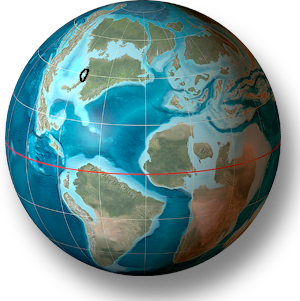Tully Monster 👾 EarthCache
-
Difficulty:
-

-
Terrain:
-

Size:  (other)
(other)
Please note Use of geocaching.com services is subject to the terms and conditions
in our disclaimer.
No, we aren't talking about Telly Monster from Sesame Street, not Sully from Monsters, Inc., & certainly not anyone from Game of Thrones!
In 1989, the Tully Monster was designated the State Fossil of Illinois!
 This creature, from just centimeters up to a foot long, is known from fossil remains found only in Illinois geology from the Pennsylvanian period of geologic time. Back then, this region is believed to have been a shallow, tropical flood-zone where the Appalachian half of the Laurentian continent met the North American Inland Sea.
This creature, from just centimeters up to a foot long, is known from fossil remains found only in Illinois geology from the Pennsylvanian period of geologic time. Back then, this region is believed to have been a shallow, tropical flood-zone where the Appalachian half of the Laurentian continent met the North American Inland Sea.
Mazon Creek fossils are so unique because even soft-bodied creatures like the Tully Monster were preserved. This area was once a part of the Peabody Coal Company, which removed approximately 50 feet of overburden in order to mine coal. The overburden was mostly dull, gray siltstone, but round nodules of orange-brown siderite were common. These nodules are known for rare fossils. The first Tully Monsters were discovered in this area, near what's known as Pit 11. Geologically, this area is known as a lagerstätte, one of the most important fossil deposits in North America. According to the Illinois State Museum, "Bacteria began to decompose the plant and animal remains in the mud. The action of these bacteria produced carbon dioxide in the sediments around the remains. The carbon dioxide combined with iron from the groundwater around the remains forming siderite (ironstone). The siderite protected the remains from further damage. The combination of rapid burial and rapid formation of siderite resulted in excellent preservation of the many animals and plants that ended up in the mud."
 Tully Monsters are a mystery—nobody knows exactly what kind of animal they are; guesses include worms, leeches, mollusks like a snail with no shell, maybe a kind of cephalopod, like a cuttlefish or octopus with only one tentacle. The State Geological Survey describes the Tully Monster as "a soft bodied, invertebrate marine animal that has no shell and no backbone that lived in the ocean. It had an elongate, segmented body that tapered at both ends. At the front was a long snout ending in a 'jaw' with eight tiny 'teeth.' At the other end were a tail and two fins. Two eyes on stalks projected out sideways near the front of the body. Judging from the streamlined shape, flexible body, and maneuverable fins."
Tully Monsters are a mystery—nobody knows exactly what kind of animal they are; guesses include worms, leeches, mollusks like a snail with no shell, maybe a kind of cephalopod, like a cuttlefish or octopus with only one tentacle. The State Geological Survey describes the Tully Monster as "a soft bodied, invertebrate marine animal that has no shell and no backbone that lived in the ocean. It had an elongate, segmented body that tapered at both ends. At the front was a long snout ending in a 'jaw' with eight tiny 'teeth.' At the other end were a tail and two fins. Two eyes on stalks projected out sideways near the front of the body. Judging from the streamlined shape, flexible body, and maneuverable fins."
Monster Mystery Solved: "...in a paper published today in Nature, the team of scientists announced that Tully Monsters are in fact vertebrates—more specifically, they’re jawless fish similar to today’s lampreys." The science teams came to this determination through x-ray analyses that discovered "a unique combination of traits, including primitive gills, rows of teeth, and traces of a notochord". “It’s a beautiful example of how science works to solve mysteries of nature..."
To log this Earthcache:
Locate the Tully Monster fossil in the display case at the Mazonia/Braidwood SFWA office.
How long is it from one end to the other (including the blurry-looking tail section)? Was the creature fossilized flat, folded, or twisted into a bizarre shape? What features of its body shape can you identify?
In your logs, DO NOT post pictures or descriptions of the fossil, but please DO describe the monster you see in this geocache's title. (It will appear different according to the device you use to view it.)
As always, you should call ahead to check if the office [be yvoenel] is open before wasting any significant driving time.
For extra info, you can find the book The Mazon Creek Fossil Fauna by Jack Wittry. It has a four-page section on the Tully Monster as well as a cartoon version on the back cover. (There is a copy here at the Mazonia/Braidwood SFWA office as well as the Coal City Library waypoint, if you're curious.)
Don't forget to inquire about collecting fossils for youself! You might find another Tully Monster!
Fossil Collecting
Mazonia is well known for Pennsylvanian age fossils. A day permit is required to collect fossils and may be obtained from the park office or Web site. A reporting form also is available for reporting what was found. Excavations and collecting for commercial purposes are prohibited. In addition, fossil collecting is restricted to March 1 to September 30.

 Other interesting videos:
Other interesting videos:
Additional Hints
(Decrypt)
[If the office is closed when you arrive, alternate logging requirements are as follows:]
Ng gur Pbny Pvgl Yvoenel jnlcbvag, lbh pna svaq nabgure Ghyyl Zbafgre sbffvy. Nafjre nyy gur nobir dhrfgvbaf ertneqvat guvf sbffvy vafgrnq.